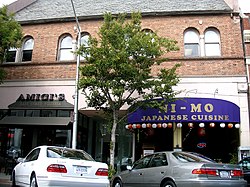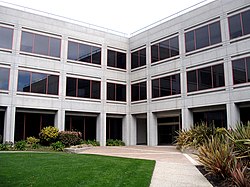From left to right: Chad Hurley, Steve Chen, and Jawed Karim
YouTube was founded by Chad Hurley, Steve Chen, and Jawed Karim, who were all early employees of PayPal.
[6] Hurley had studied design at Indiana University of Pennsylvania, while Chen and Karim studied computer science together at the University of Illinois at Urbana-Champaign.
[7]
According to a story that has often been repeated in the media, Hurley and Chen developed the idea for YouTube during the early months of 2005, after they had experienced difficulty sharing videos that had been shot at a dinner party at Chen's apartment in San Francisco. Karim did not attend the party and denied that it had occurred, while Hurley commented that the idea that YouTube was founded after a dinner party "was probably very strengthened by marketing ideas around creating a story that was very digestible".
[8]
YouTube began as a venture-funded technology startup, primarily from a $11.5 million investment by Sequoia Capital between November 2005 and April 2006.
[9] YouTube's early headquarters were situated above a pizzeria and Japanese restaurant in San Mateo, California.
[10] The domain name
www.youtube.com was activated on February 14, 2005, and the website was developed over the subsequent months.
[11]
The first YouTube video was entitled
Me at the zoo, and shows founder Karim at the San Diego Zoo.
[12] The video was uploaded on April 23, 2005, and can still be viewed on the site.
[13]
YouTube offered the public a beta test of the site in May 2005, six months before the official launch in November 2005. The site grew rapidly, and in July 2006 the company announced that more than 65,000 new videos were being uploaded every day, and that the site was receiving 100 million video views per day.
[14] According to data published by market research company comScore, YouTube is the dominant provider of online video in the United States, with a market share of around 43 percent and more than 14 billion videos viewed in May 2010.
[15] YouTube says that over 48 hours of new videos are uploaded to the site every minute, and that around three quarters of the material comes from outside the US.
It is estimated that in 2007 YouTube consumed as much bandwidth as the entire Internet in 2000.
[18] Alexa ranks YouTube as the third most visited website on the Internet, behind Google and Facebook.
[19]
The choice of the name
www.youtube.com led to problems for a similarly named website,
www.utube.com. The owner of the site, Universal Tube & Rollform Equipment, filed a lawsuit against YouTube in November 2006 after being overloaded on a regular basis by people looking for YouTube. Universal Tube has since changed the name of its website to
www.utubeonline.com.In October 2006, Google Inc. announced that it had acquired YouTube for $1.65 billion in Google stock, and the deal was finalized on November 13, 2006.
[22] Google does not provide detailed figures for YouTube's running costs, and YouTube's revenues in 2007 were noted as "not material" in a regulatory filing.
[23] In June 2008, a
Forbes magazine article projected the 2008 revenue at $200 million, noting progress in advertising sales.
[24]
In November 2008, YouTube reached an agreement with MGM, Lions Gate Entertainment, and CBS, allowing the companies to post full-length films and television episodes on the site, accompanied by advertisements in a section for US viewers called "Shows". The move was intended to create competition with websites such as Hulu, which features material from NBC, Fox, and Disney.
In November 2009, YouTube launched a version of "Shows" available to UK viewers, offering around 4,000 full-length shows from more than 60 partners.
[27] In January 2010, YouTube introduced an online film rentals service,
[28] which is currently available only to users in the US.
The service offers over 6,000 films.
[31]










